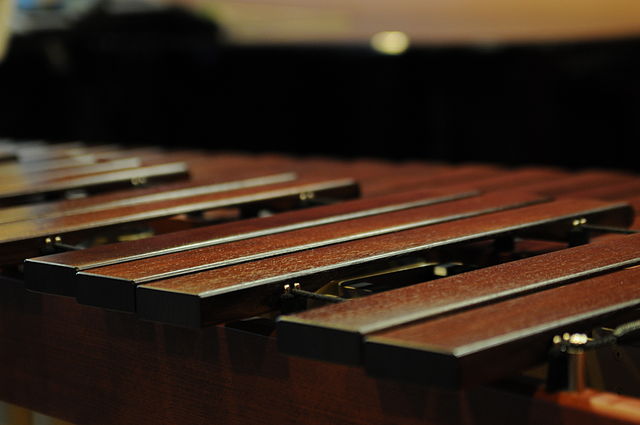Idiophonic vibration
Idiophones are a diverse family of musical instruments that produce sound through self-vibration.
Their entire body vibrates to create tones without the need for strings or membranes.
Examples range from tuned keyboards such as marimbas & xylophones through to delicate handbells and powerful gongs, showcasing the spectrum of musical expression available through the inherent properties of an instrument’s material and shape.
To facilitate illustration, we discuss the marimba bar below
The enchanting tones of a marimba emanate from the intricate dance of its bars, each vibrating in a carefully orchestrated symphony. To delve into the mechanics of a marimba’s bar vibration is to embark on a journey where physics meets artistry.
At the heart of a marimba’s magic lies the principle of resonance. Each wooden bar possesses a unique pitch determined by its size, density, and the material from which it’s crafted. When a mallet strikes the bar, it initiates a cascade of events that transform the kinetic energy of the impact into an auditory marvel.
Upon impact, the mallet imparts its energy to the bar, causing it to deform momentarily. This deformation is not chaotic but follows a precise pattern dictated by the bar’s physical properties. The bar flexes, bending and curving as if choreographed by an invisible force. This flexing, however slight, is crucial for the generation of sound.
As the bar flexes, it stores potential energy in its structure. This potential energy is the key to the bar’s vibration. The stored energy pushes the bar back towards its original position, setting up a rhythmic oscillation. It’s akin to a dance between stability and flexibility—a perpetual motion that sustains the resonance.
The bar’s oscillation is not a solitary affair; it involves the entire body of the marimba. The frame acts as a sounding board, absorbing and amplifying the vibrations initiated by the bar. The resonators beneath the bars further amplify and shape the sound, giving each note its distinct timbre.

To understand the mechanics more deeply, we must explore the concept of modal nodes. As a bar vibrates, it forms nodes and antinodes—points of minimal and maximal displacement. These nodes determine the frequencies at which the bar vibrates. The fundamental frequency corresponds to the bar’s overall length, while higher-order harmonics involve more complex patterns of nodal lines.
The bar’s vibrational modes are like the bar’s unique fingerprint, defining its sonic identity. The craftsmanship of the instrument, including the selection of wood and precise tuning, plays a pivotal role in shaping these vibrational modes.
In the realm of marimba construction, the tuning process involves carefully adjusting the length, width, and thickness of each bar to achieve the desired pitch and harmonics. This meticulous craftsmanship ensures that each bar contributes harmoniously to the overall symphony of the marimba.
Beyond the physics, the artistry of a marimba player comes into play. The striking technique, the choice of mallets, and the dynamics of each stroke influence the bar’s response. A skilled player can coax a rich spectrum of tones from the bars, exploiting the instrument’s full expressive potential.
In essence, the beauty of a marimba’s sound lies in the convergence of scientific principles and artistic finesse. The vibrating bars, with their nuanced dance of nodes and antinodes, create a melodic tapestry that captivates the listener—a testament to the harmonious marriage of physics and musicality.

